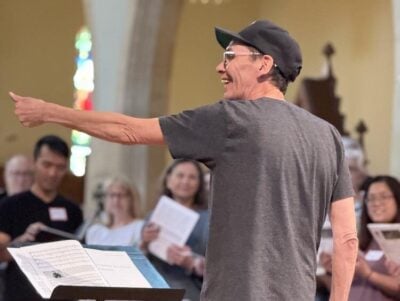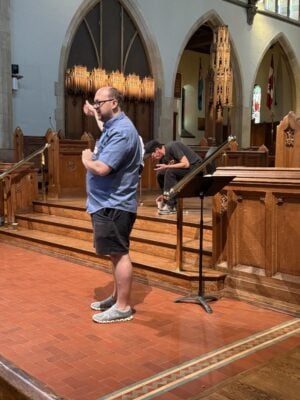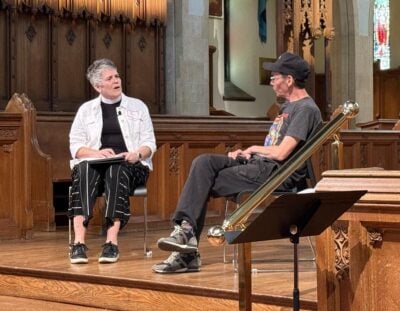
Singers from many different choirs across the city gathered at Christ Church Cathedral Ottawa on June 14 for a workshop with renowned composer and director Andrew Balfour. Together, they filled the Cathedral with music that beautifully mingles choral works with Indigenous perspectives and language.
Balfour directed the composite choir through two of his original compositions and two of his arrangements of 16th century music by Thomas Tallis and Orlando Gibbons.
The workshop coincided with the tenth anniversary of the release of the Truth and Reconciliation Commission’s report, and Balfour spoke about his experience of being one of thousands of children who suffered the systemic abuse of being taken away from their Indigenous families in the 60s Scoop. “I was taken away from my medicine, my language, my blood mother, my brothers and sisters and connections,” he said.
“However, I landed in a wonderful, loving family. My father was an Anglican priest at All Saints Anglican Church in Winnipeg,” he recounted as he introduced himself. His adoptive family was also a very musical family, which is how Balfour was exposed to a very broad range of music as a child, including choral music as a choir boy.
There were early indicators of his passions and talents. As a child, he would play at being a conductor. Hearing the opening of Bach’s St. Matthew’s Passion was when he was eight or nine was “mind-blowing,” he shared. “I learned the codes,” he added, “how to make music, when I was six or seven years old.” That opened the door to his career as a singer, composer, conductor and sound designer that has taken him to across Canada and the world.
Along the way, there was also a difficult journey to reconnect with his Cree identity.
Balfour found a way to unite the two worlds musically. In a description of his album Nagamo, he explained that “by taking the choral music of the Elizabethan masters and other later choral music, I have reshaped the thoughts behind the texts, by changing the Latin to Ojibway or Cree perspectives. These are not direct translations of the sacred texts, rather a more Indigenous perspective of spirituality, but keeping the beauty of the polyphony intact.”
Ispiciwin (Journey) combines Cree text with the 16th century music of Orlando Gibbons’ ‘Drop, Drop Slow Tears.’
Four Directions brings Ojibway text together with 16th century music from Thomas Tallis “Te lucis ante terminum” (To thee before the close of the day), a hymn written to be sung at Compline, the last service of the day. Four Directions calls for the singers to add bird song into the piece at times, evoking the peacefulness of evening.
Qilak is Balfour’s original composition inspired by a trip he made to Baffin Island and is a collaboration with Iqaluit folksinger and songwriter Madeleine Allakariallak with English and Inuktitut text. Balfour told the singers at the Cathedral that when he arrived on Baffin Island, far north of the tree line, he was struck by the immensity of the land and the sky, which inspired this work.
Ambe is also Balfour’s original composition based on and inspired by an original song in Ojibway gifted to Balfour and the University of Manitoba Concert Choir by traditional drummer and singer Cory Campbell. The notes with the score say that Campbell describes the song as “a call to the people to the ceremonial way of life or the red road.” Balfour explains that “the steady beat throughout represents the heartbeat of Mother Earth and the lyrical first soprano melody that emerges from this rhythmic texture at measure seven conveys the powerful totem of the eagle which represents the teaching of love, wisdom and strength.”
Andrew McAnerney, associate music director for Christ Church Cathedral, said he was really grateful to Balfour for coming to Ottawa. “As was apparent to everybody, he’s a very accomplished musician. He’s a great director and artist,” he said, noting that he is in high demand and working on many projects.

McAnerney was delighted that the workshop drew singers from 15 to 20 different choirs. “That was tremendous work to get those 70 plus people together and singing those works… There was a range of difficulty. The Ispiciwin piece was relatively straightforward, whereas the Ambe piece with all its sorts of rhythms and syncopation was quite a challenge, especially because he didn’t take it slowly at all. He went full speed from the start.” Most of the singers participated in a pre-workshop rehearsal with McAnerney and were helped by having the music to study in advance, he said.
McAnerney said that singing the songs in the three different Indigenous languages “opened a window for us.” Balfour generously helped to bridge the gaps and open “a connection to a different world of music making. That was really special to have him there to explain it.”
The morning workshop also included a conversation with the Cathedral’s Dean Beth Bretzlaff asking Balfour some questions. He spoke about his love of Bach’s music and that first time hearing St. Matthew’s Passion and his memories of first travelling to England as a choir boy and singing in a cathedral that was 1,000 years old.

When she brought up the tenth anniversary of the Truth and Reconciliation Commission’s report, Balfour shared his admiration for the commission’s chair, Murray Sinclair, who passed away last year. He recalled listening to testimony at the TRC hearings in 2012 from 12 grandmothers, who were in their seventies and eighties at the time. “I suddenly saw them as young, vulnerable children. How is it possible, that just down the street, the master of the universe, John A. MacDonald, and all of those racist people made decisions to send those children away?”
He said that he sees hope in education and the fact that young people in Canada are learning about that history now, and in the work of Indigenous artists as a force for change and healing.
He added that the word reconciliation is misleading because there never was a time of peace and good relations to return to, but he echoed Sinclair’s words that “Reconciliation is an ongoing journey, not a destination.”
There were many compliments from the singers who attended. Susan Johnston, whose children are part of the Cathedral choirs, told Perspective that she came out of curiosity and an appreciation for seeing an act of reconciliation through music.
Loutchka Prophete, a parishioner at Christ Church Cathedral, said: ‘Singing together brings us together.” She compared it to Kintsugi, the Japanese art of repairing pottery using gold to join the broken pieces. “We must find the link, common ground, and these activities give us that common ground.”
The next day, Christ Church Cathedral’s Sunday Choral Eucharist marked the National Indigenous Day of Prayer as well as Trinity Sunday. Balfour was a guest director, and the Cathedral choir sang Ispiciwin and Ambe. That service was lives-treamed and can still be viewed on the Cathedral’s YouTube channel.







Listening for God’s voice in a time of change